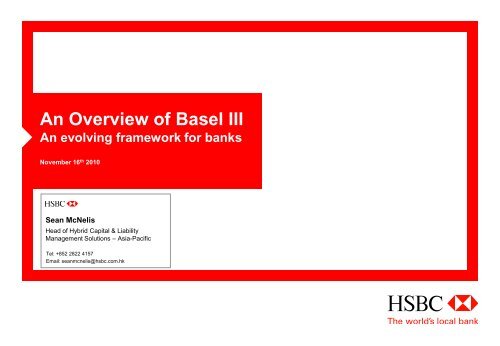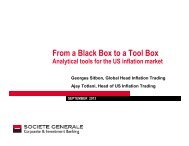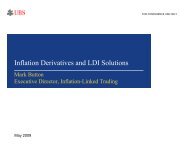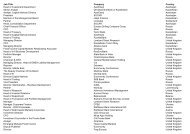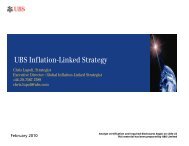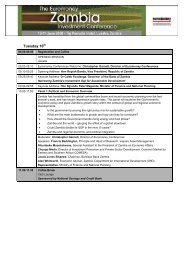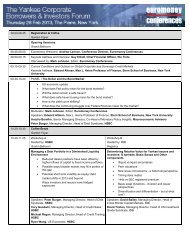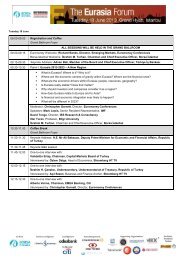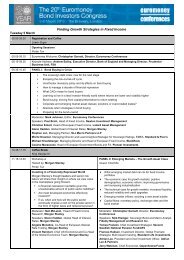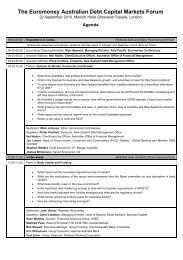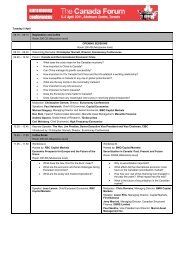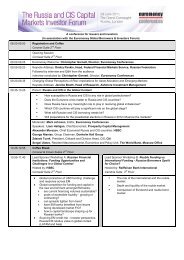An Overview of Basel III - Euromoney Conferences
An Overview of Basel III - Euromoney Conferences
An Overview of Basel III - Euromoney Conferences
Create successful ePaper yourself
Turn your PDF publications into a flip-book with our unique Google optimized e-Paper software.
<strong>An</strong> <strong>Overview</strong> <strong>of</strong> <strong>Basel</strong> <strong>III</strong><br />
<strong>An</strong> evolving framework for banks<br />
November 16 th 2010<br />
Sean McNelis<br />
Head <strong>of</strong> Hybrid Capital & Liability<br />
Management Solutions – Asia-Pacific<br />
Tel: +852 2822 4157<br />
Email: seanmcnelis@hsbc.com.hk
The Background to <strong>Basel</strong> 3<br />
<strong>Overview</strong> Key Changes<br />
<strong>Basel</strong> 2 focused on „asset side‟ <strong>of</strong> B/S.<br />
<strong>Basel</strong> 3 focuses mostly on „liability side‟:<br />
– definition <strong>of</strong> capital<br />
– liquidity<br />
Post the Global Financial Crisis, focus <strong>of</strong><br />
regulation on :<br />
– Longer-term / stable liquidity<br />
– Leverage ratios (RWA framework<br />
can‟t be arbitraged)<br />
– Higher quality <strong>of</strong> capital (e.g. equity,<br />
CoCos, loss absorbing hybrids)<br />
– Higher quantity <strong>of</strong> capital<br />
√ Focus on equity<br />
√<br />
√<br />
New regulations on the definition<br />
<strong>of</strong> T1 & T2 debt capital<br />
New (higher) minimum capital<br />
requirements<br />
√ Leverage ratios<br />
√ Liquidity ratios (LCR & NSFR)<br />
2
<strong>Basel</strong> 3 & Bank Capital<br />
Definition <strong>of</strong><br />
Capital<br />
Capital<br />
Deductions<br />
Liability<br />
Management<br />
Contingent<br />
Capital<br />
Minimum<br />
Capital Ratios<br />
Focus on core equity / Hybrids to be more “equity-like”<br />
No step-ups in Tier 1 or Tier 2 capital<br />
Upper and Lower Tier 2 distinction abolished; Tier 3 abolished<br />
Most deductions from regulatory capital now against core equity<br />
What is the relevance <strong>of</strong> T2?<br />
Banking groups with significant DTAs, minorities, insurance subsidiaries most affected<br />
Opportunistic buy-back <strong>of</strong> hybrids at lower prices (create accounting gains)<br />
Address „old‟ structures via tenders / exchange / modification – UT2 Capital<br />
Final grandfathering rules under <strong>Basel</strong> 3 will be key<br />
Certain regulators & Governments (UK / Canada/ Switzerland) favour contingent capital to<br />
deal with future banking crises<br />
Debt instrument that a) converts to equity or b) is written down when the bank in crisis<br />
Limited demand from investors for the product currently<br />
Higher minimum capital ratios – equity T1 ratios from 2% to 7%<br />
National regulators have discretion – capital conservation buffer & countercyclical buffer<br />
3
The December 2009 <strong>Basel</strong> Proposals<br />
• The <strong>Basel</strong> Committee on Banking Supervision (BCBS) released in December 2009 a consultation<br />
document titled “Strengthening the Resilience <strong>of</strong> the Banking Sector”<br />
Key Areas Under Review<br />
• The regulatory capital<br />
base, quality,<br />
consistency and<br />
transparency<br />
• Capital requirements for<br />
counterparty credit risk<br />
• Introduction <strong>of</strong> a<br />
leverage ratio<br />
• Countercyclical capital<br />
framework<br />
• Minimum liquidity<br />
standard<br />
The Proposals<br />
Planned Implementation Timeline<br />
• Full set <strong>of</strong> standards by the end <strong>of</strong> 2010 (on track!!)<br />
• Full implementation is aimed for by the end <strong>of</strong> 2018<br />
Steps<br />
2010 2011-2012 2012-2018<br />
Consultation<br />
Period<br />
(End-2010) Release<br />
<strong>of</strong> final standard<br />
Standards phased<br />
into regulatory<br />
framework<br />
Aimed implementation<br />
4
<strong>Basel</strong> <strong>III</strong> Consultation & Implementation Timeline<br />
• Aug 2010 – CP on<br />
loss absorption<br />
• Nov 2010 – G20<br />
meeting in Korea<br />
• Dec 2010 – Final<br />
T1 & T2 rules<br />
2009 2010 2011 2012 2013 2014 2015 2016 2017 2018<br />
• Dec 2009 –<br />
consultative<br />
document titled<br />
“Strengthening the<br />
resilience <strong>of</strong> the<br />
banking sector”<br />
Implementation timeline runs to 2018<br />
• Jan 2013 – New minimum<br />
capital requirements<br />
• Jan 2013 – Amortisation <strong>of</strong><br />
non-compliant Hybrid T1 & T2<br />
(10% p.a.)<br />
• Jan 2013 – Exclusion <strong>of</strong> noncompliant<br />
common equity T1<br />
• Jan 2013 – “Parallel Run” for<br />
leverage ratio<br />
• Jan 2011 –<br />
Supervisory<br />
monitoring<br />
begins for<br />
leverage ratios<br />
• Jan 2014 –<br />
New capital<br />
deduction<br />
requirements<br />
• Jan 2016 – Phase in <strong>of</strong><br />
the capital conservation<br />
buffer<br />
• Jan 2015 –<br />
Bank level <strong>of</strong><br />
disclosure <strong>of</strong><br />
Leverage<br />
Ratio<br />
• Jan 2018 –<br />
Leverage ratio as<br />
Pillar 1 test<br />
• Jan 2018 –Revised<br />
Net Stable Funding<br />
Ratio<br />
5
Re-Defining the Capital Base…<br />
The <strong>Basel</strong> <strong>III</strong> proposals redefine the composition <strong>of</strong> regulatory capital<br />
Under the proposals:<br />
– Focus on core equity<br />
– Innovative Tier 1 (with step-up feature) would not be recognised<br />
– Upper Tier 2 is abolished<br />
CHINA’S CURRENT BANK<br />
CAPITAL FRAMEWORK<br />
Lower Tier 2<br />
Upper Tier 2<br />
Core Tier 1<br />
Tier 1<br />
<strong>Overview</strong> <strong>of</strong> Bank Capital Structure<br />
INTERNATIONAL BANK CAPITAL<br />
FRAMEWORK<br />
Tier 2<br />
Hybrid<br />
Tier 1<br />
Core<br />
Tier 1<br />
Tier 3<br />
Lower Tier 2<br />
Upper Tier 2<br />
Innovative Tier 1<br />
Non-Innovative Tier 1<br />
Core Tier 1<br />
PROPOSED BASEL <strong>III</strong><br />
FRAMEWORK<br />
Tier 2<br />
Contingent Capital<br />
Hybrid Tier 1<br />
Core Tier 1<br />
6
Update on <strong>Basel</strong>’s Minimum Capital Standards (Sept 2010)<br />
• On 12 September 2010, the <strong>Basel</strong> Committee announced the new minimum capital<br />
requirements. Final rules expected in Dec 2010<br />
Minimum Capital Requirement<br />
• Minimum common equity ratio<br />
increases from 2% to 4.5%<br />
Total Capital<br />
8.0%<br />
Common Equity<br />
(after<br />
deductions)<br />
4.5%<br />
Tier 2<br />
Hybrid<br />
Tier 1<br />
Core<br />
Tier 1<br />
Tier 1<br />
Capital<br />
6%<br />
Capital Conservation Buffer<br />
• Capital conservation buffer <strong>of</strong> 2.5%<br />
must be met with common equity<br />
(after regulatory adjustment)<br />
Total Capital<br />
10.5%<br />
Tier 2<br />
Common Equity Hybrid<br />
(after<br />
Tier 1<br />
deductions)<br />
7.0%<br />
Capital<br />
Conserv.<br />
Buffer<br />
Core<br />
Tier 1<br />
Tier 1<br />
Capital<br />
8.5%<br />
2.5%<br />
Countercyclical Buffer<br />
• A countercyclical buffer<br />
(0.0%~2.5%) <strong>of</strong> common equity or<br />
other loss absorbing capital will be<br />
introduced<br />
Total Capital<br />
10.5~13.0%<br />
Common Equity<br />
(after<br />
deductions)<br />
7.0~9.5%<br />
Tier 2<br />
Hybrid<br />
Tier 1<br />
Countercyclical<br />
Buffer<br />
Capital<br />
Conserv.<br />
Buffer<br />
Core<br />
Tier 1<br />
Tier 1<br />
Capital<br />
8.5~11.0%<br />
0.0~2.5%<br />
2.5%<br />
7
New Definition for Hybrid Tier 1 Instruments<br />
• The biggest impact <strong>of</strong> the proposed new <strong>Basel</strong> rules is likely to stem from the removal <strong>of</strong> stepups,<br />
more stringent requirements for coupon discretion as well as a stronger form <strong>of</strong> principal<br />
loss absorption<br />
Tier 2<br />
Contingent Capital<br />
Hybrid Tier 1<br />
Core Tier 1<br />
Features<br />
No step-ups<br />
Non-cumulative<br />
Loss absorption<br />
• Resolution regimes • ‘Bail in’<br />
T1 hybrids more “equity-like”<br />
8
New Definition for Tier 2 Instruments<br />
• With the exception <strong>of</strong> the removal <strong>of</strong> step-ups, the proposed Tier 2 rules are in many respects<br />
similar to existing Tier 2 rules. Debate on adding “non-viability” triggers continues<br />
Tier 2<br />
Contingent Capital<br />
Hybrid Tier 1<br />
Core Tier 1<br />
Features<br />
No step-ups<br />
Loss absorption at the point <strong>of</strong> “non-viability”<br />
• Resolution regimes • ‘Bail in’<br />
T2 debt more risky for investors<br />
9
Latest Proposals On Regulatory Capital Loss Absorption<br />
• The <strong>Basel</strong> Committee issued a consultative document titled “Proposal to Ensure the Loss<br />
Absorbency <strong>of</strong> Regulatory Capital at the Point <strong>of</strong> Non-Viability” on Aug 19 2010<br />
• All non-common equity bank regulatory capital instruments (including Tier 2 and Hybrid Tier 1<br />
capital) should be capable <strong>of</strong> absorbing losses in the event that a bank is unable to support itself in the<br />
private market, through:<br />
– Permanent write-down <strong>of</strong> principal; or<br />
– Conversion to equity<br />
Regulatory Capital Loss Absorbency<br />
Rationale <strong>Basel</strong> Proposed Solution<br />
• Many regulatory capital instruments do not<br />
absorb losses in gone-concern situations<br />
• During the Global Financial Crisis, banks<br />
capital instruments have not taken losses in<br />
many circumstances (even where the<br />
Government invested in the bank)<br />
• Gone-concern loss absorbency would continue<br />
to work through subordination in liquidation for<br />
failed banks<br />
• The regulatory authority has the option to<br />
require non-common equity regulatory capital<br />
instruments to be permanently written-<strong>of</strong>f or<br />
converted into common shares<br />
10
Introduction <strong>of</strong> a Leverage Ratio… by 2018<br />
Objectives<br />
Latest<br />
Review<br />
Put a floor under the build-up <strong>of</strong><br />
leverage in the banking sector<br />
Provide additional backstop<br />
against model risk and<br />
measurement errors<br />
Stop “arbitraging” <strong>of</strong> RWA<br />
approach<br />
BCBS Original Proposals<br />
The Leverage Ratio is designed as a<br />
supplementary measure to the <strong>Basel</strong> II<br />
risk-based framework with a view to<br />
migrating to a Pillar 1 treatment<br />
Netting is not allowed<br />
Certain Off-Balance Sheet items should<br />
be included using a flat 100% Credit<br />
Conversion Factor<br />
Key Idea<br />
Migrating leverage ratio from a Pillar 3<br />
to a Pillar 1 treatment based on future<br />
review and calibration<br />
Min.<br />
Capital<br />
Req.<br />
<strong>Basel</strong> II<br />
Pillar 1 Pillar 2 Pillar 3<br />
Supervisory<br />
Review<br />
Process<br />
Key Amendments (vs. Dec09 Proposals)<br />
Proposed minimum 3% (i.e. 33 times leverage)<br />
to be tested, based on new definition <strong>of</strong> Tier 1<br />
capital<br />
Calculated as an average over a quarter<br />
For all derivatives netting is allowed<br />
Market<br />
Discipline<br />
10% Credit Conversion Factors for Off-Balance<br />
Sheet items<br />
11
A role for Hybrid Capital in the Future?<br />
• Banks tend to use subordinated debt to enhance RoE, whilst meeting reg. requirements<br />
• Tax deductible “equity” will continue to make sense for banks<br />
Regulatory<br />
Capital<br />
Non-Dilutive<br />
Lower Cost<br />
Diversificatio<br />
n<br />
Equity Credit<br />
Can be recognised by regulators as Tier 1 or Tier 2 in calculating the issuing bank‟s<br />
capital adequacy, depending on local regulations<br />
Structured as a fixed-income instrument without voting rights and thus is non-dilutive to<br />
existing shareholders (other than where equity conversion is included)<br />
Lower cost <strong>of</strong> capital due to its “quasi-equity” nature and tax benefits<br />
More favorable WACC compared to the use <strong>of</strong> pure equity capital<br />
Expansion <strong>of</strong> possible sources <strong>of</strong> regulatory capital<br />
Diversification <strong>of</strong> investor base (issue in foreign currency)<br />
Tax Benefits Tax deduction on interest is a key driver <strong>of</strong> issuance<br />
Equity credit from rating agencies in financial analysis<br />
12
Existing Bank Capital Framework in Asia-Pacific<br />
Timeline <strong>of</strong><br />
introducing<br />
Hybrid Tier 1<br />
Dec. 1998 Mar 1999 Sep 1999 Sep 2001 Dec 2002 Oct. 2003 May 2004 Dec 2004 Dec 2005 Jan 2006<br />
regulations Japan Thailand Australia Hong Kong Korea Taiwan Singapore Malaysia Philippines India China<br />
Lower Tier 2<br />
Upper Tier 2<br />
<br />
<br />
Hybrid Tier 1 <br />
Capital regulations are well developed across the Asia-Pacific region<br />
<strong>Basel</strong> 3 will lead to changes in the definition <strong>of</strong> capital in the region<br />
China will be in a position to adopt the new <strong>Basel</strong> 3 capital rules allowing banks to issue the<br />
new generation <strong>of</strong> instruments across the capital spectrum<br />
<br />
13
The role for Contingent Capital?<br />
<strong>Basel</strong> review has also identified the merits <strong>of</strong> contingent capital<br />
Switzerland, Canada and the UK are big proponents <strong>of</strong> contingent capital as a<br />
useful tool to re-capitalise banks in any future financial crisis<br />
The Swiss proposals consider the use <strong>of</strong> contingent capital for up to 9% <strong>of</strong> RWAs<br />
The <strong>Basel</strong> Committee will consult further on contingent capital before July 2011<br />
What is<br />
Contingent<br />
Capital?<br />
• <strong>An</strong> instrument that can be converted into a higher form <strong>of</strong> capital<br />
(or equity)<br />
• It allows an issuer to pre-secure higher quality regulatory capital<br />
for a future date and to avoid execution uncertainty<br />
• Can be generated by e.g. issuing a senior or subordinated bond<br />
which embeds a conversion option into a higher tier <strong>of</strong> capital<br />
(<strong>of</strong>ten equity)<br />
14
Forms <strong>of</strong> Contingent Capital<br />
Examples <strong>of</strong> structuring alternatives<br />
Contingent Capital<br />
Senior debt / Tier 2 instrument exchangeable into a Tier<br />
1 capital bond (hybrid capital) at any time at the<br />
issuer’s full option. The terms <strong>of</strong> the Tier 1<br />
instruments are pre-defined at the launch, however the<br />
coupon can be reset upon exchange (examples –<br />
Deutsche Bank UT2 / T1 contingent capital transaction)<br />
Senior debt / Tier 2 where principal is permanently<br />
written down based on a trigger event (example –<br />
Rabobank)<br />
Senior debt / Tier 2 instrument exchangeable into equity<br />
based on a pre-defined trigger. The number <strong>of</strong> shares<br />
/ share price on exchange is set out at the time <strong>of</strong><br />
issuance <strong>of</strong> the bond (example – Lloyds ECNs)<br />
Optimization <strong>of</strong> balance<br />
sheet<br />
Cost-efficient funding<br />
Risk management tool<br />
15
Q & A<br />
16
Disclaimer<br />
The Hongkong and Shanghai Banking Corporation Limited (“HSBC”) has prepared this document (the “Document”) for information purposes<br />
only. This Document does not constitute a commitment to underwrite or purchase or subscribe for all or any portion <strong>of</strong> the securities mentioned<br />
herein. <strong>An</strong>y such commitment shall be evidenced only by a fully executed subscription agreement, purchase agreement or similar contractual<br />
document. This Document should also not be construed as an <strong>of</strong>fer for sale <strong>of</strong> or subscription for any investment, nor is it calculated to<br />
invite/solicit any <strong>of</strong>fer to purchase or subscribe for any investment.<br />
HSBC has based this Document on information obtained from sources it believes to be reliable but which it has not independently verified.<br />
HSBC makes no guarantee, representation or warranty and accepts no responsibility or liability for the contents <strong>of</strong> this Document and/or as to its<br />
accuracy or completeness and expressly disclaims any liability whatsoever for any loss howsoever arising from or in reliance upon the whole or<br />
any part <strong>of</strong> the contents <strong>of</strong> this Document. HSBC and its affiliates and/or its or their respective <strong>of</strong>ficers, directors and employees may have<br />
positions in any securities mentioned in this Document (or in any related investment) and may from time to time add to or dispose <strong>of</strong> any such<br />
securities (or investment). HSBC and/or any <strong>of</strong> its affiliates may act as market maker or have assumed an underwriting commitment in the<br />
securities <strong>of</strong> any companies discussed in this Document (or in related investments), may sell them to or buy them from clients on a principal or<br />
discretionary basis and may also perform or seek to perform banking or underwriting services for or relating to those companies. As HSBC is<br />
part <strong>of</strong> a large global financial services organisation, it or one or more <strong>of</strong> its affiliates may have certain other relationships with the parties<br />
relevant to the proposed activities as set out in this Document, and these proposed activities may give rise to a conflict <strong>of</strong> interest, which the<br />
addressee hereby acknowledges.<br />
No consideration has been given to the particular investment objectives, financial situation or particular needs <strong>of</strong> any recipient. This Document,<br />
which is not for public circulation, must not be copied, transferred or the content disclosed to any third party and is not intended for use by any<br />
person other than the addressee or the addressee's pr<strong>of</strong>essional advisers for the purposes <strong>of</strong> advising the addressee hereon.<br />
The Hongkong and Shanghai Banking Corporation Limited<br />
Level 16 HSBC Main Building<br />
1 Queen‟s Road Central<br />
Hong Kong SAR<br />
© Copyright. The Hongkong and Shanghai Banking Corporation Limited 2010, ALL RIGHTS RESERVED. No part <strong>of</strong> this publication may be<br />
reproduced, stored in a retrieval system, or transmitted, on any form or by any means, electronic, mechanical, photocopying, recording, or<br />
otherwise, without the prior written permission <strong>of</strong> The Hongkong and Shanghai Banking Corporation Limited.<br />
17


